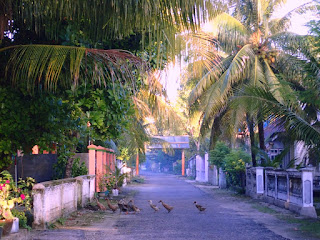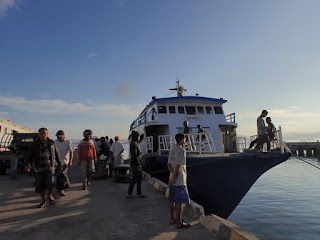Singkawang is a small town 3 hours from Pontianak in West Kalimantan. Though small, it has a very unique tradition that makes this town so big and rich in the whole cultural context of Indonesia.
It is held around 2 weeks after Chinese New Year, or in conjunction with the celebration of Cap Go Meh. While Cap Go Meh itself is celebrated by many Chinese communities in many parts of the world, but in Singkawang, it becomes more than just a parade of dragon and lion dancers that are commonly seen in many Chinese related celebrations.
The assimilation of Dayak and Chinese
tradition has developed a kind of ritual with the intention of calling all the good
spirits to protect the community all year round. These spirits, will be called
upon to enter the body of tatung - or people that are chosen by the Chinese
priest. A person who is chosen to be a tatung should fast for three days before
the festival, and there are also other rituals and steps that he or she (yes,
there are also women!), must do before the festival begins.
Once possessed by the good spirit, a tatung
is believed to have supernatural power, able to ward off any evil spirits even
to cure illnesses.
--
The parade starts off from a shrine, after
asking for the blessing of To Pe Kong, one of the saint, so that the whole
festival can be smooth. They also dress up - either as Chinese warriors or
saints, or as Dayak warriors.
During the parade, they also show that they
cannot be harmed by knife, sword, or any other sharp objects. Once in a while
they should drink a kind of arrack, or even the blood of chicken, as part of
the ritual to keep their power.
 |
| The chair with blades. Yes, they sit on it |
 |
| Don't try this at home |
 |
| Not that easy to see but this guy is standing on the chair with blades |
 |
| Care to hold a blade like that? |
 |
| Can you blame her for having that smug look on her face, when she can sit on a chair made of blades? |
Looking at how the parade was held, listening to all the chants and costumes, I could really feel the true assimilation of Chinese Taoism with
Dayak’s animism.
And to be a witness of it,
was a bit mind-boggling. Imagine this: the parade started at around 11, nearing
the mid-day prayer. So while all the priests and tatung went in and out of the
different shrines, accompanied by the rub-a-dub-dub of the drums, in not from a
long distance I could hear Quran recital played from the mosque’s loudspeaker
noting that it was soon mid-day prayer time.
And to see Chinese lampions all the way
from Pontianak to Singkawang, also all over Singkawang, all the dragons and
lions, made me felt that it was a totally different place. The experience of
seeing tatung festival makes me realise more and more of how abundantly
different Indonesia is, something that we should be able to live with
peacefully.
Tatung festival is one of those that I think one should see at least once in a lifetime, to really feel how diverse Indonesia really is.
--
How to get there:
Information on the exact dates for the
festival is not easy to get. We have a friend in Pontianak who informed us
about the dates. So it is always best to find a local contact to get the right
dates. But roughly, it will be around 13 - 14 days after the Chinese New Year, or on the day of Cap Go Meh. It is usually held for 2 days with the final day being the biggest. We
came for the first day, and that was already quite an experience.
To go to Singkawang, you should first fly
to Pontianak. There are direct flights from Jakarta to Pontianak. Then it is
around 3 hours drive to Singkawang. It is an easy drive - with not much traffic
on a smooth road.
Be prepared to book your hotel in
Singkawang months ahead because many people come to see this festival as it is
the biggest tatung parade in the world.
Or you can also stay in Pontianak, take a 3
hours drive to Singkawang, and go back on the same day. We did just that
because we could not get a hotel in Singkawang. We noticed that some people did
that too.
And we would recommend you spend a day or
two in Pontianak.
While Singkawang has tatung festival, Pontianak also has its own: dragon and lion dance festival. Quite a feast to see the colourful dragons and lions.
If you are non-muslim, then you can have a lot of feast in this city!. Lots of various noodle dishes, and a variety of rice. Seafood is also a highlight!.
If you are interested in a bit of history, then I highly recommend you to go to the Palace of Kadriah. The palace is very beautiful and well maintained. It keeps the story of Sultan Hamid II - who was the original creator of Indonesia's national symbol, the Garuda. This story was never really told publicly.
 |
| A story of how Indonesia's country symbol, the Garuda, was first created by Sultan Hamid II |
 |
| Beautifully built, beautifully maintained |
 |
| The throne |
 |
| The palace's mosque |
 |
| Inside the mosque |
 |
| You can watch life goes by along Kapuas river |
 |
| Or in the afternoon, there are boats that you can hire to go along Kapuas (we could not do it as it rained. February is unfortunately the rainy season) |
Pontianak is actually also a city where the equator line passes right through. There is a park where the equator monument is placed. But when we were there it was under renovation. So if you're lucky, that's also a worth to visit location, maybe. Just to stand right where that line passes through.
(R I R I)



































